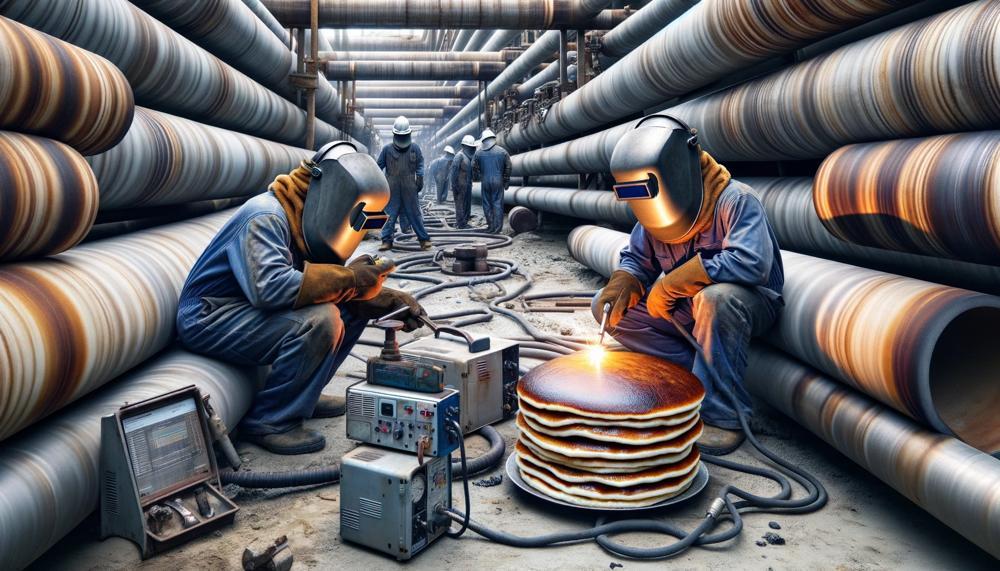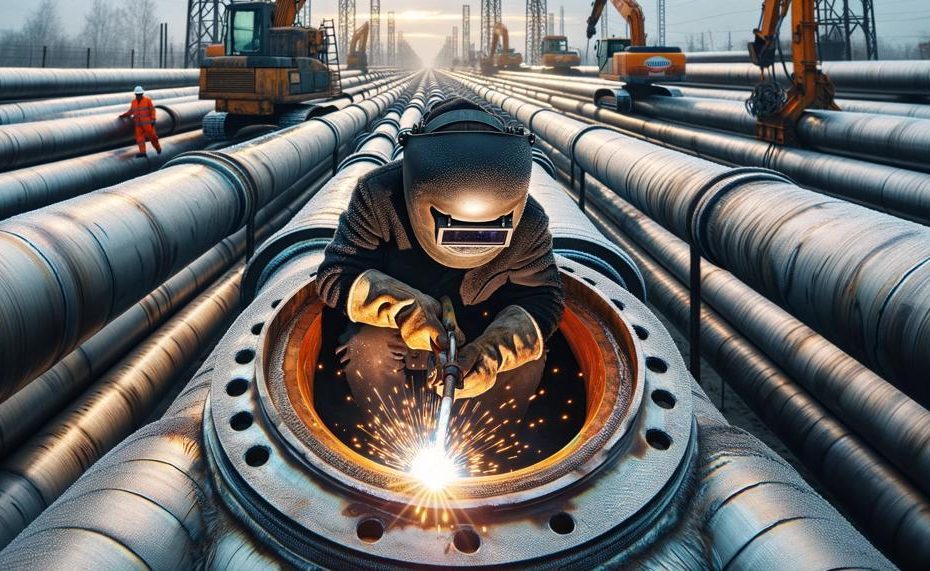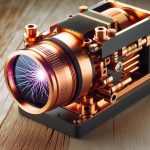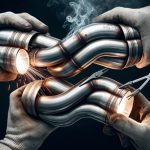In the world of pipeline construction, welders face a set of challenges as unique and demanding as the landscapes they work in.
Among the tools of their trade, one stands out for its distinctive design and critical purpose: the pancake hood. This piece of personal protective equipment is more than just a quirky choice; it’s a carefully considered solution to the myriad of hurdles that come with pipeline welding.
In this blog post, we’ll dive deep into the reasons behind this choice, shedding light on why these hoods have become synonymous with safety, efficiency, and comfort in one of the toughest welding environments around.
So, why do pipeline welders wear pancake hoods?
Pancake hoods shield pipeline welders’ eyes from sparks and UV rays as they work, as well as help them prevent backlight reflections off the hood. Like snorkel goggles, pancake hoods are designed to fit tightly against the face. Around the eyes of the hood is a little balsa wood box that contains the welding lens. There is no backlight since the box is hand-carved to suit the wearer’s face. Some claim that since pancakes don’t have glare, they’re simpler to make and better for operations that don’t splatter.
For welders, hoods, or welding helmets, are essential personal protective equipment (PPE). They shield the skin and eyes from sparks as well as the arc’s potentially blinding UV and infrared radiation.
So, let’s get started.
Contents
- 1 Benefits of Wearing a Pancake Welding Hood
- 2 Are Pancake Welding Hoods OSHA Approved?
- 3 What Kind of Helmet Should You Wear for Pipeline Welding?
- 4 Why Do Pipeline Welders Wear Pancake Hoods?
- 5 Are Some Welding Helmets Flat?
- 6 Can You Wear a Hard Hat with a Pancake Welding Hood?
- 7 How to Choose the Right Pancake Welding Hood
- 8 Tips on Using a Pancake Welding Hood
- 9 Conclusion
Benefits of Wearing a Pancake Welding Hood
The benefits of wearing a pancake welding hood for pipeline welders are multifaceted, enhancing both safety and work efficiency.
These specialised hoods cater to the unique demands of pipeline welding, providing features that traditional helmets can’t match. Here’s a breakdown of their advantages:
| Feature | Benefit | Impact on Pipeline Welders |
|---|---|---|
| Wider Shade Range (10-14) | Superior UV Radiation Shielding | Protects eyes from intense light and radiation, reducing eye strain and fatigue. |
| Flat Lens Design | Larger Viewing Area with Less Distortion | Improves visibility and precision, making it easier to work in tight or awkward spaces. |
| Durable Materials | Enhanced Protection | Shields the face from sparks and debris, extending the hood’s lifespan. |
| Custom Fit Adjustability | Comfort for Long Hours | A snug fit with a sweatband keeps the welder comfortable and focused. |
| Lightweight and Compact | Ease of Use in Confined Spaces | Facilitates maneuverability and reduces neck strain in cramped conditions. |
| OSHA-Approved | Compliance with Safety Standards | Ensures the wearer’s safety is up to regulatory standards, offering peace of mind. |
| Compatibility with Hard Hats | Added Protection | Offers extra safeguarding in hazardous areas, preventing head injuries. |
For pipeline welders, the pancake welding hood is more than just a piece of equipment; it’s a critical companion that ensures their safety, comfort, and effectiveness on the job.
Its design caters specifically to the challenges faced in pipeline welding, making it an indispensable tool for those in the field.
Are Pancake Welding Hoods OSHA Approved?
Answer: Pancake welding hoods, those compact shields beloved by pipeline welders for their snug fit and clear view, do indeed fall under the watchful eye of OSHA. This federal body, tasked with keeping workers across the board in fine fettle, sets down guidelines ensuring these hoods are up to snuff.
It’s not about slapping an “OSHA Approved” sticker on each piece, but making sure they meet the muster under the Personal Protective Equipment (PPE) standard (29 CFR 1910.132) and welding-specific standards (29 CFR 1910.252).
So, when a welder dons a pancake hood, they’re not just wearing any old thing; they’re kitted out in gear that’s passed the litmus test for safety in the sparks-and-heat heavy world of pipeline welding.
The Nitty-Gritty on Pancake Welding Hoods and OSHA:
| Feature | OSHA Standard | What It Means for Welders |
| Fit and Coverage | 29 CFR 1910.132 | Each hood must snugly protect the welder’s face and neck from the hazards of the job. |
| Protection from Hazards | 29 CFR 1910.252 | The hood must fend off heat, sparks, and harmful radiation, keeping the welder safe. |
| Training and Maintenance | 29 CFR 1910.132 | Welders are schooled in the correct use and up-keep of their hoods, ensuring longevity and safety. |

Employer Responsibilities:
Employers are the linchpins in this system, tasked with providing the right gear and ensuring it’s used as intended.
They’re not just outfitting their team; they’re educating them on the perils of welding and how a good pancake hood can be the difference between a job well done and a trip to the emergency room.
OSHA’s Role:
Beyond setting standards, OSHA keeps a keen eye on the field. Through inspections and the enforcement of their standards, they make sure these guidelines are more than just words on paper.
Violations aren’t taken lightly, with penalties that can hit the wallet hard, emphasizing the seriousness with which OSHA takes the safety of welders.
What Kind of Helmet Should You Wear for Pipeline Welding?
For pipeline welding, donning the right helmet is not just a matter of following protocol; it’s about ensuring your safety in an environment where sparks fly and hazards loom.
The pancake hood stands out as the champion choice for this rigorous task, blending unparalleled protection with the finesse needed for precision work.
Why Choose a Pancake Hood?
| Feature | Pancake Hood | Traditional Helmets |
| Protection | Shields against sparks, debris effectively | Offers basic coverage |
| Visibility | Superior, with a clear, unobstructed view | Can be limited, depending on design |
| Comfort | Light, adjustable, custom fit | Often heavier, less tailored fit |
| Safety Compliance | Meets OSHA standards | Varies by model and make |
| Material Durability | Withstands extreme temperatures | Material quality varies |
| Additional Features | Auto-darkening lenses, better air circulation | May lack advanced features |
Distinct Advantages of Pancake Hoods
- Precision and Protection: The pancake hood’s design ensures that welders can see clearly what they’re working on, without sacrificing safety. The flat lens area reduces glare and offers a wide field of vision, making it easier to execute precise welds on pipelines.
- Cool and Comfortable: With its lightweight build and air circulation features, the pancake hood keeps you cooler under the helmet—a boon during the long, grueling hours pipeline welding often entails.
- Customizable Fit: Unlike one-size-fits-all models, pancake hoods come with adjustable headbands and lenses, ensuring a snug, comfortable fit that stays in place, even in awkward positions or tight spaces.
- Enhanced Safety: Adhering to OSHA’s stringent safety standards, these hoods offer more than just eye protection; they’re built to keep you safe from environmental hazards, with options to integrate hard hats for those especially perilous jobs.
In contrast to other helmets, the pancake hood is specifically tailored for the challenges of pipeline welding. It offers not just a shield against the physical perils of the job, but also the clarity and comfort needed to do the work right.
Why Do Pipeline Welders Wear Pancake Hoods?
Pipeline welders opt for pancake hoods due to their unique blend of protection, comfort, and practicality. These helmets stand out in the demanding world of pipeline welding, offering a tailored solution that meets the specific needs of welders working in challenging conditions.
| Feature | Benefit | Impact on Welder |
| Robust Protection | Shields from UV radiation, sparks | Reduces risk of burns and eye damage |
| Clearer Visibility | Flat lens, wide shade range | Enhances precision and safety |
| Lightweight Design | Better air circulation | Increases comfort for longer wear |
| Adjustable Fit | Custom fit with sweatband | Improves stability and focus |
| OSHA Compliance | Meets safety standards | Ensures legal and safety compliance |
So, the decision to wear pancake hoods by pipeline welders is driven by their unparalleled ability to provide superior protection, enhanced visibility, and unmatched comfort in the taxing conditions of pipeline welding.
Are Some Welding Helmets Flat?
Yes, some welding helmets are flat, specifically designed as pancake welding helmets, which are quite distinct from the more commonly seen curved or domed welding helmets. These flat, pancake-shaped helmets serve a crucial role in the arsenal of gear for pipeline welders.
Let’s break down the key benefits that make flat welding helmets, or pancake hoods, an indispensable choice for those braving the welds on pipelines.
| Feature | Benefit | Detail |
| Flat, Pancake Shape | Enhanced Visibility in Confined Spaces | The unique flat design permits welders to see clearly in tight or awkward spaces, crucial for the intricate work required in pipeline welding. |
| Durable Materials and OSHA Approval | Reliability and Safety | Made from robust materials that meet rigorous safety standards, these helmets ensure a welder’s face and eyes are shielded from sparks, UV, and IR radiation. |
| Custom Fit and Comfort | Extended Wear without Discomfort | Adjustable features and lightweight design allow for a snug, comfortable fit, reducing fatigue during long welding sessions. |
| Wide Shade Range (10-14) | Superior UV Protection | A wider range of shade levels provides optimal protection against varying intensities of light, offering better eye safety. |
| Air Circulation | Keeps Welders Cool | The design promotes airflow, helping to cool the welder’s face, a boon during prolonged use or in hot environments. |
| Compatibility with Hard Hats | Added Protection from Debris | When combined with a hard hat, the pancake hood offers an extra layer of protection against falling debris or accidental impacts. |
The benefits outlined showcase why a flat welding helmet, particularly the pancake hood, is not just a preference but a necessity for pipeline welders. Its design and features cater specifically to the demands of welding in challenging environments, marrying safety with functionality.
Can You Wear a Hard Hat with a Pancake Welding Hood?
Absolutely, donning a hard hat alongside a pancake welding hood whilst engaged in pipeline work isn’t just safe; it’s practically a game-changer for ensuring top-notch safety and comfort.
This combo caters to the dire need for both head and face protection from not only sparks and debris but also from the potential of falling objects and bumps within confined or hazardous spaces.
Essential Features to Consider:
- Protection and Compliance: Both the hard hat and pancake welding hood offer a fortress of safety. The hoods are lauded for their superior defence against the harsh glare and sparks of welding, also being OSHA-approved signals they meet stringent safety standards. The hard hat serves as the first line of defence against impacts that could occur in the bustling environment of pipeline construction.
- Comfort and Adaptability: The lightweight design and adjustable straps of pancake welding hoods ensure a snug fit without compromising comfort, making long hours on the job less of a strain. The flat design is not just about style; it significantly improves visibility and minimises distortion in the welder’s line of sight, a crucial factor when precision is the name of the game.
- Material and Durability: Crafted from materials that can brave extreme temperatures, pancake welding hoods are not just about immediate protection. Their durability means they stand the test of time against the rigours of pipeline work. Teaming this with a hard hat ensures a double shield against the elements and accidents.
Choosing the Right Gear:
When selecting the ideal pancake welding hood and hard hat combination, there are a few boxes to tick to ensure you’re getting the best in terms of safety and functionality:
| Feature | Consideration | Benefit |
| OSHA Approval | Look for OSHA-approved gear | Ensures compliance with safety standards |
| Adjustable Features | Check for adjustable straps and fit | Enhances comfort and ensures a snug fit |
| Material Quality | Assess the durability of the materials used | Guarantees longevity and resistance to extreme conditions |
| Safety Features | Familiarize yourself with all safety aspects | Maximises protection during use |
Coupling a hard hat with a pancake welding hood spells out a robust defence mechanism for welders navigating the challenging terrains of pipeline work.
How to Choose the Right Pancake Welding Hood
When selecting the right pancake welding hood for pipeline welding, you’re not just picking a piece of equipment; you’re ensuring your safety and comfort during those long, demanding hours on the job.
Here’s a breakdown of the crucial factors to consider:
| Comfort | Look for a hood with adjustable straps and a sweatband. Comfort is key during extended welding sessions. |
| Durability | Choose materials like carbon fiber or high-grade plastic for resilience against the rigors of pipeline work. |
| Protection | An auto-darkening lens shields your eyes from harmful UV and IR rays while offering clear visibility of the weld pool. |
| Weight | A lighter hood reduces neck strain, making it easier to work for longer periods without discomfort. |
| Shield Coverage | Ensure the tin shield effectively guards your face and ears against sparks and spatter. |
| Material Quality | Opt for a hood made of materials that won’t degrade quickly, offering long-term protection and value. |
| Adjustability | The ability to adjust the fit ensures the hood stays securely in place, regardless of head movement. |
| OSHA Approval | Verify that the hood meets safety standards set by the Occupational Safety and Health Administration. |
Pancake welding hoods stand out for their encompassing eye safety, especially with their auto-darkening lenses, and the flat design that provides an unobstructed view of your work area. They’re also designed to be worn comfortably with hard hats, an essential for pipeline welders working in hazardous areas.
Remember, a good fit not only keeps you safe but also ensures you can focus on your welding with unparalleled clarity and protection.
Tips on Using a Pancake Welding Hood
When utilizing a pancake welding hood for pipeline welding, there are several crucial tips to keep at the forefront of your mind. These tips are pivotal for ensuring your safety, comfort, and the effectiveness of your welding work.
Choosing the Right Hand Orientation
Ensure you pick a pancake hood that matches your dominant hand. This choice is paramount for comfort and functionality.
Adjusting the Balsa Box
Fine-tune the balsa box, or eye box, for a snug fit. This adjustment prevents light leakage, ensuring clear vision through the lens.
Proper Shield Use
Make use of the protective shield to guard against harmful radiation. This shield is a barrier between you and the intense light of welding.
Comfortable Strap Adjustments
Adjust the straps for a comfortable, secure fit. A well-fitted hood won’t distract you by slipping or shifting.
Regular Maintenance
Keep your hood in tip-top shape. Regularly check for wear and tear and clean the lens for unobstructed vision.
OSHA Compliance
Verify that your pancake hood meets OSHA’s rigorous safety standards. This compliance is non-negotiable for your protection.
Brand Consideration
Consider reputable brands like Sarges, Wendy’s, and Miller. They are celebrated for their quality and reliability.
Conclusion
The selection of protective gear in the harsh and merciless realm of pipeline welding is not only about safety but also about incorporating comfort, usefulness, and accuracy into the labor-intensive skill of welding. Specifically designed to handle the special requirements of pipeline welding, the pancake hood stands out as a symbol of this integration.
Its unique design, which combines a minimalist aesthetic with a fitted fit, effectively meets the demands of welders, who need protection from severe welding arc flares, environmental adaptability, and a design that allows for extended periods of comfortable usage in confined places.
Despite its apparent simplicity, this equipment reflects a deep awareness of the conditions faced by welders. It provides unmatched eye protection with a broader variety of shades and a flat lens design for a sharper, more accurate image. The selection of long-lasting materials guarantees a barrier that endures over time in addition to providing protection from sparks and debris.
Because pipeline building sites provide a variety of risks, adjustability and compatibility with hard helmets demonstrate a sophisticated approach to safety.
Choosing a pancake hood is about more than just picking out a piece of gear; it’s about accepting a friend that has been painstakingly designed to protect you, increase your productivity, and provide comfort during those long, exhausting hours on the pipeline.





